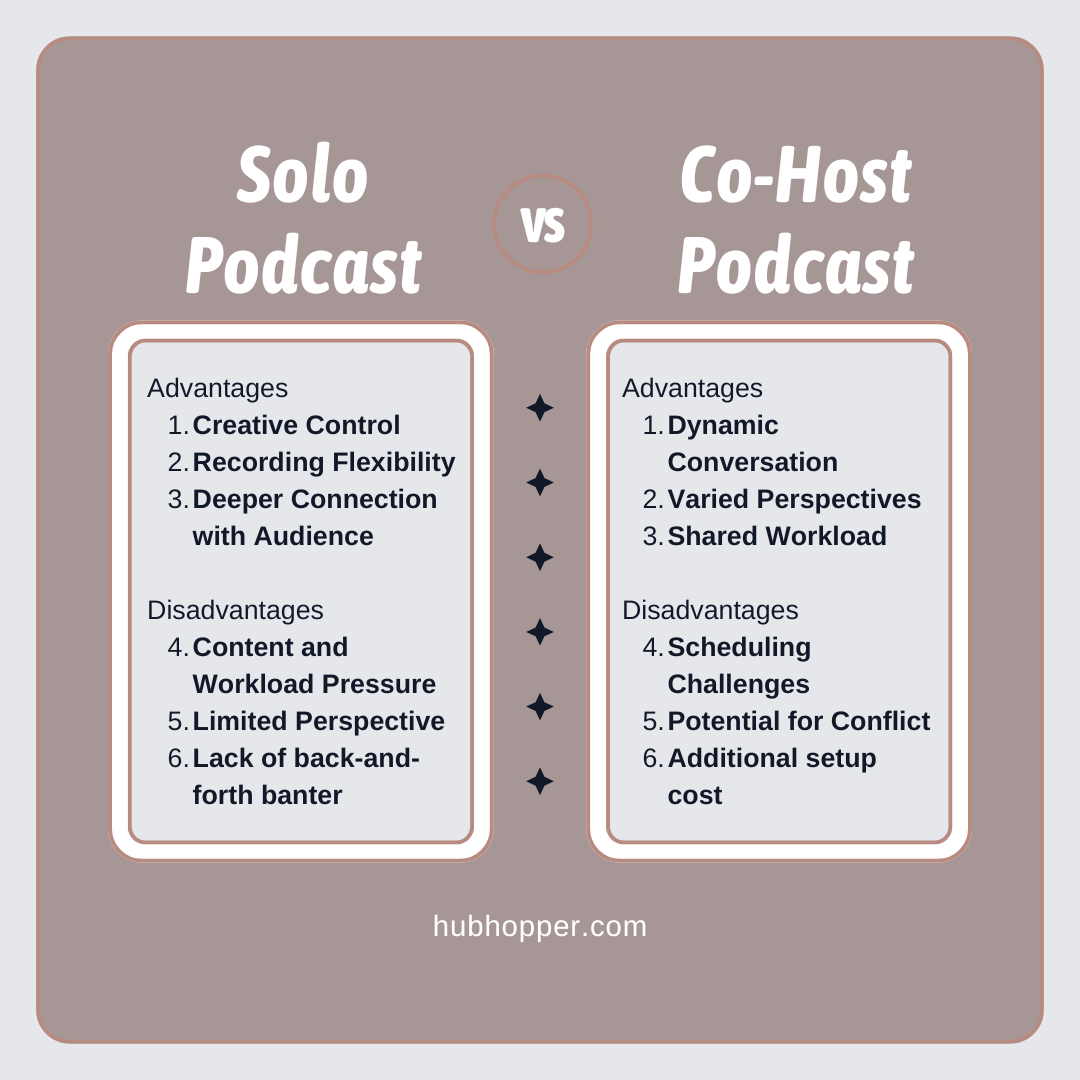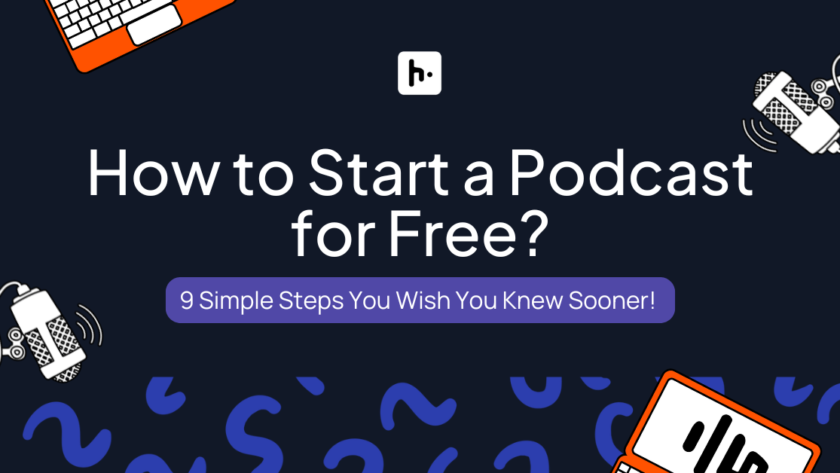Yes, it is totally possible to start a podcast for free. With the magical little device in all our pockets – smartphones, starting a podcast has never been so accessible and simple. And if you have a laptop, you can take the quality of your podcast to another level by properly planning your podcast. In this blog, I will give you a step-by-step guide on how to start a podcast for free.
After reading this blog, you won’t need to read any other guide on starting a podcast.
How To Start A Podcast Without Spending Money On Equipment And Tools?
To start your podcast you require an idea, a name, a cover art, a place to write your script, record your audio, and a podcast hosting platform to distribute and manage your podcast.
Here is a breakdown of free tools you can use for each phase of your podcasting journey:
- Idea: this would require a bit of soul searching and trying to figure out three essential things – what you can talk about, which people will be interested in it, and how many episodes you can have. If you’ve got these three things figured out, you’re on a much better track than 99% of podcasters out there. I’ve covered this in depth later in the blog.
- Name: Once your idea is solidified, the next thing is to find a name. The most crucial point to remember is to keep it simple and short. Here’s a blog that covers how to come up with a name and some name ideas to get your creative juices flowing.
- Cover Art: Canva is a free tool you can use to design your cover.
- Scripting: Google Docs is great to pen down your script and make changes as you go. You can also use ChatGPT to help you with editing it.
- Audio Podcast Recording: Your smartphone and earphones. There are also simple alternatives you can utilize to improve your audio quality. You can swap a pop filter with socks, just use it to cover your earphones mic and it takes care of the popping sounds one can make. Lay thick bed sheets in the room while recording to reduce the echo.
- Video Podcast Recording: If you opt to create a video podcast, your smartphone comes in handy. Most smartphones have a great camera to record your podcast. Apps like InShot make it easy to edit your podcast on your smart device itself.
- Editing: You can use Hubhopper’s free audio recorder and editor to record as well as edit on your laptop. It is user friendly and takes care of basic editing.
If you have experience editing audio, Audacity is a great free tool to edit your podcast to add music and sound effects to your podcast. Adobe Podcast helps you edit your audio easily with its ability to clean your audio and remove background noise for crystal clear audio. - Podcast Hosting: For your podcast to be available on various distribution platforms, get analytics, and upload podcast episodes consistently you need a podcast hosting platform. There are many podcast hosting platforms but since you’re looking for an All in One solution, a one stop podcast hosting solution is Hubhopper. There’s a free plan that lets you do all of the above to get started at no cost.
This is the bare minimum you need for starting a podcast for free. Here is a concise list of software and hardware you’ll need.

How To Start A Podcast For Free: 9 Steps
Now that you know what all tools you’ll need, let’s actually get your podcast up and running in nine steps. If you follow these steps you can start a podcast and take it live in less than 24 hours.

Coming Up With A Podcast Idea
How can you create a podcast that stands a class apart from the rest? A killer podcast idea with your unique voice is the combination that creates a podcast that breaks the clutter.
Many people want to start a podcast, but they’re not sure what it should be about. And even if they do have a concept, they often wonder whether it will truly resonate with listeners. A simple solution for this is to think about three things:
- What can I talk about for hours?
- Which type of people will tune in and would be interested in?
- How many episodes can I make about a certain topic?
A simple example could be a podcast about Cryptocurrency. Perhaps, you’ve been following the cryptocurrency trends and have knowledge base that you want to share with the world.
The kind of people that would tune in would be people who want to know more about cryptocurrency and have burning questions about it. What would these people care about? What kind of episodes would they tune in to? These questions then get you thinking in a direction more focused on providing valuable content to your listeners.
The third question gives you an idea whether it will be a limited series or not. Cryptocurrency is a whole ocean to explore and there are frequent changes in the space. Your podcast can then follow a weekly frequency. It gives you an idea about the number of episodes you can produce without affecting its quality.
Moreover it helps you assess whether this topic is worth making a podcast for. If you are struggling to come up with less than 10 episodes, then it’s better to move on to newer pastures.
A simple exercise you can do is three columns, list down all the topics you’re interested in, who would tune in, and 10 episode ideas. You can copy and paste this ChatGPT prompt to aid you in identifying episodes if you’re struggling.
“You’re a seasoned podcast strategist with deep knowledge of [insert industry/topic]. I need 10 captivating episode ideas that will resonate with [type of audience—e.g., beginner podcasters, marketing professionals, tech enthusiasts].
Please ensure each idea is designed to spark curiosity and engage our listeners from start to finish.”
You can reject or accept ideas and note down the ideas you like on a sheet of paper. Assess the sheet of paper to finalize your podcast topic.
Choose Your Podcast Format
After you’ve figured out your podcast idea, it’s time to come up with a format. There are two common formats that most podcasts fall into – solo or co-host podcasting format. As the name suggests, solo podcasts are podcasts with just one host, sharing their thoughts and opinions on the topic.
On the other hand, co-host podcasts have more than one host.
Here are the pros and cons of each of these formats, you can take your pick on which format suits you best.

Create Podcast Artwork
Another crucial element of your podcast is the cover art for it. The simplest and cost effective way to create one is using Canva. Canva already has a ton of templates you can use. Just make changes to it according to the vibe and tone of your podcast and voila, you’re done.
Here’s an extensive guide on how to make your cover art if you ever want to revamp or change it. It covers every aspect of making a great cover art. Also note, that you can always change your cover art, so the best thing you can do now is to make your podcast cover art quickly.
Setup Podcast Equipment
As we’ve discussed you don’t need a very big setup if you’re just getting started. With simple hacks and things you already have, you can record an episode and clean up the audio once you sit down to edit it.
Audio Podcast
For an audio podcast you just need your laptop or smartphone, connect your earphones to your device and use a thick sock to act as a pop filter. A pop filter makes the audio cleaner by taking care of the sounds that one can make saying words starting with b or p. A thick sock can act as a makeshift pop filter.
Eliminate background noises by trying to turn off the fan and ACs. Recording at night can also offset noises one can have when they live in a busy environment.
Some people also record under a thick blanket to remove all the noises. With these few tricks you get cleaner audio without spending any money.
Video Podcast
For a video podcast, your video and audio quality both matter. Most smartphones can capture high quality videos. For top notch video quality set it to the highest resolution possible. You can use an open source camera app that lets you adjust these settings.
Lighting is another factor that matters; try to use natural lighting to film your videos to make yourself appear the best. A clutter free background also removes visual clutter and keeps the focus on you instead of that messy desk.
For better audio quality, use earphones and keep them close to your mouth to ensure that it catches your voice better than the rest of the noise. With the tools mentioned in the blog, you can clean up your audio without paying massive money for an expensive mics.
As you eventually scale you can invest in a good mic to reduce your work of editing and cleaning up your audio.
Record Your First Episode
Your first episode should ideally be a trailer for your podcast, which acts as your podcast intro and gives all the necessary information to create intrigue in your listeners.
Here’s a trailer episode script you can follow.
It’s a quick under a minute script that you can customize as per your podcast and take your podcast live within 24 hours! Now that you know how to set up your equipment to get the best audio/video quality, set it up and get recording!
Hey there! I’m _________, and Welcome to ___________, where we dive into the __________. This isn’t just any podcast—it’s your go-to for ___________, all served with a side of __________
So, join me every _________ for a fresh episode. You can reach out to me on different social media platforms, my handles are _______ Subscribe to never miss out! Oh, and don’t forget to ______________ I can’t wait to share this journey with you.
Edit Your Audio
Once you’ve recorded the trailer, editing it is the next step. Since the audio is super short, the editing will barely take you a lot of time.
It’s important to know that your inner perfectionist can kick in during this process and it is important to only take out major flaws from your audio to keep the episode organic. Small hiccups and imperfections add to the episode and prevent you from sounding like a robot.
Choose Your Podcast Software
The key softwares you require for a podcast are your editing and podcast hosting software. You can clean your audio files with Adobe Podcast. They use their AI technology to remove background noise. Next, you’ll need a software to edit your audio and remove filler words (ahs and umms) and trim anything you don’t want to include in your episode.
You can use Hubhopper’s free recording and editing software. No need to download it, you can edit the audio online.
Once your episode is ready and edited, you need a podcast hosting platform to create your RSS feed and distribute your episode to various podcast directories. With Hubhopper’s Basic Plan, you host and manage a podcast with its free podcast hosting.
Distribute your podcast to 10+ podcast platforms, view all your analytics, and edit your audio within the platform as well, so you don’t need to juggle between softwares. The next step takes you through the five simple steps to set up your podcast on Hubhopper. Try it out today for free:
Starting A Podcast For Free With Hubhopper
You’ve got all your puzzle pieces in place, all you have to do is now get them all together. This is where you sign up to the best podcast hosting platform for your podcast. With Hubhopper, your podcast setup is just simple 5 steps:
- Podcast Details: Enter your podcast name and podcast description. Our AI helps you get a podcast description if you just enter your podcast concept.
- Podcast Cover Art Next, you need to upload your podcast artwork. With our Canva integration, you just need to simply choose the podcast cover art you made and you’re done. You can also upload your covert art directly if you used another tool to make it.
- First Episode: You need to upload your first episode audio file. If you have a video podcast you can extract the audio file and upload it. We’ll soon be releasing a video podcast feature as well that lets you upload video directly.
- Episode Details: Next, you need to put the episode name and description. Again, you can use our AI feature to get your episode description.
- Distribute: All that’s left is to distribute your episode and that happens with just one click!!
You’re officially a podcaster now! Congratulations, you can now continue putting out great episodes. Once you consistently put out episodes you can leverage analytics to measure success. You can see which episodes are getting more traction than others and produce more episodes like that. Tracking your analytics is the way to grow your podcast.
Keep Your Listeners Close
How do you make a podcast a success? Create a community of your listeners to interact with them and make them loyal to your podcast. They’re also great to gather feedback, get help on the ideal episode length, more episode ideas, and spread the word about your podcast. Here’s a quick guide on how to create a community for your podcast that helps you step by step on how to do so.
FAQs On How to Start A Podcast For Free
How do I start a podcast?
To start your podcast you need an idea, a name, a cover art, a place to write your script, ability to record your audio, and a podcast hosting platform to distribute and manage your podcast.
How to distribute your podcast?
To distribute your podcast you need to be on a podcast hosting platform. It is the host that ensures your podcast gets distributed everywhere.
Do podcasts make money?
Yes, podcasts make money via different models. Some of the common models are host-read ads, brand sponsorship, exclusive paid content, and merch.
Can you set up a podcast for free?
Yes, with Hubhopper you can set up a podcast for free.
Can a normal person start a podcast?
Yes, everyone has something to share with the world. You have a unique perspective to share and podcasts are a great medium to share that.
How to start a podcast for free on YouTube?
To start a podcast for free on YouTube, you can either directly upload on YouTube, add all your episodes in a playlist and make that playlist a podcast. Or you can also pick a podcast host that lets you publish on YouTube.
How to start a podcast for free on Apple Podcasts?
To start a podcast on Apple, you need to pick a free podcast hosting software that lets you distribute to Apple. So, once you upload episodes, they automatically show up on Apple Podcasts.
How much does it cost to start a podcast?
As a beginner, starting a podcast can cost you not a single penny. What you will require is consistency, an idea, and some free tools (that we mentioned in this blog).
How do you start a podcast?
A podcast idea, format, name, and a podcast hosting platform is what you need to get started.
How to make a podcast?
Your smartphone, some earphones and a topic you can talk about for hours is all you need to make a podcast and create your episodes.
How to upload a podcast to Spotify?
To upload a podcast to Spotify, you need a podcast hosting platform that distributes your podcast to Spotify.





